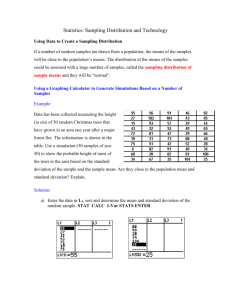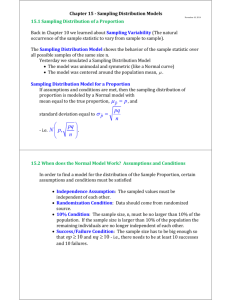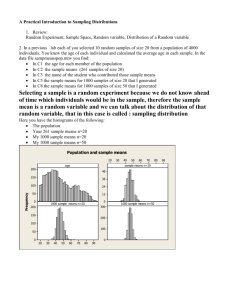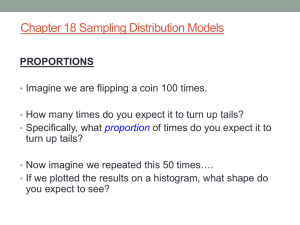Chapter 18: Sampling Distribution Models
advertisement
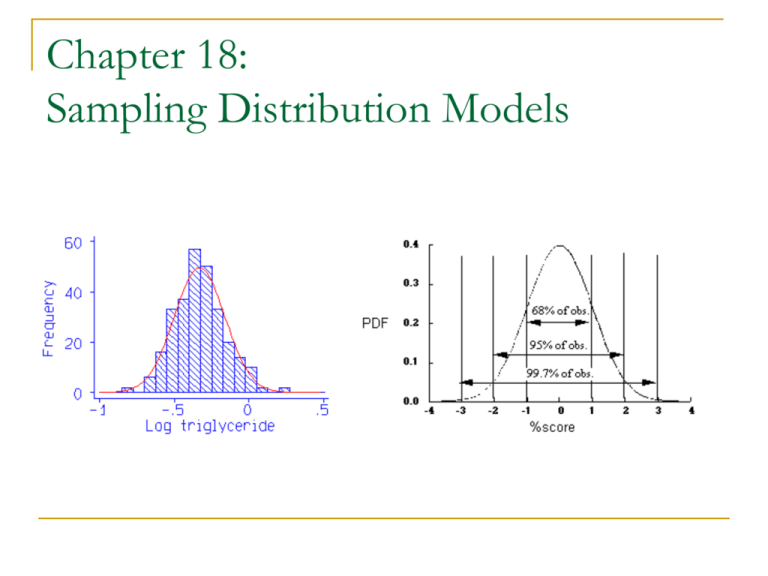
Chapter 18: Sampling Distribution Models Modeling the Distribution of Sample Proportions Simulate many independent random samples of equal size Keep the same probability of success Histogram of the proportions of the simulated samples: Unimodal Symetric Centered at p Normal Model The center of the histogram is naturally at p, so the mean of the normal, is at p. Once we know p, we automatically know the standard deviation. pq p Standard deviation: n Therefore, model the distribution of the sample proportions with a probability model that is N p, pq ; remember q 1 p n Because we have a normal curve, we can use the 68-95-99.7 Rule. Assumptions and Conditions Assumptions The sampled values must be independent of each other. The sample size, n, must be large enough. Conditions 10% condition: if the sampling has not been made with replacement, then the sample size, n, must be no larger than 10% of the population. Success/Failure condition: The sample size has to be big enough that both np and nq are greater than 10. The Sampling Distribution Model for a Proportion In other words, provided that the sampled values are independent and the sample size is large enough, the sampling distribution of p is modeled by a Normal model with mean p p, and the standard deviation SD p z p p SD p pq n Means A sample mean also has a sampling distribution Simulation: (pp. 353 – 354) Toss a pair of dice 10,000 times, take the average, and plot the histogram of the average. Now toss three die, take the average, and plot the histogram of the average. Now toss five die, take the average, and plot the histogram of the average. What is happening to the shape of the histogram? The Fundamental Theorem of Statistics Central Limit Theorem: The sampling distribution model of the sample mean (and proportion) is approximately Normal for large n, regardless of the distribution of the population, as long as the observations are independent. The Central Limit Theorem (CLT) talks about the means of different samples drawn from the same population, called a sampling distribution model. Central Limit Theorem As the sample size, n, increases, the mean of n independent values has a sampling distribution that tends towards a Normal model with mean y equal to the population mean, , and standard deviation y SD y z y SD y n . Assumptions and Conditions Random sampling condition: the values must be sampled randomly or the concept of a sampling distribution makes no sense. Independence assumption: the sampled values must be mutually independent. When the sample is drawn without replacement, use the 10% condition: the sample size, n, is no more than 10% of the population. Law of Diminishing Returns The standard deviation of the sampling distribution declines only with the square root of the sample size. The square root limits how much we can make a sample tell about the population. Standard Error Often we only know the observed proportion p or the sample standard deviation, s. Whenever we estimate the standard deviation of a sampling distribution, we call it a standard error. For a proportion, the standard error of p is For a sample mean, the standard error is SE p s SE y n pq n WATCH OUT!! Beware of observations that are not independent. Look out for small samples from skewed populations. Don’t confuse the sampling distribution with the distribution of the sample.




